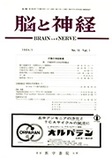Japanese
English
- 有料閲覧
- Abstract 文献概要
- 1ページ目 Look Inside
I.まえがき
脳組織は,血液脳関門によつて血行から弧立し一定の制約のもとにその物質代謝が進行していること,あるいはまた脳組織の示す物質代謝の諸相が他の多くの臓器のものと異なつていることも近時しだいに明らかにされた。このような脳組織のもつ物質代謝の上での特長が直接,間接に脳のもつ生理機能と関連していることは容易に考えられる。そしてinsituの実験からそれぞれ機能に対応して脳内の物質代謝(酸素消費,乳酸形成,pH変化など)の変化が調べられ機能との対応関係が考察されている1)。しかし機能に対応した物質変化を直接脳組織を用いて追跡するためには摘出による死後変化を最少限にとめなければならない。このために近時液体空気や液体窒素により小動物をまるごと瞬間的に凍結固定し死後変化を除外しながら脳の機能状態に対応した物質変化を追求することが可能となり脳の機能と脳内物質変化との相関を求めることを容易にした2)。
われわれは四肢からの通電刺激や条件反射を用いて白鼠の行動変化に伴う脳内アミノ酸代謝の動きを急速凍結固定法により追求した。また逆に実験的にアミノ酸の代謝異常(フェニールケトン尿症)を起こさしめこの場合の動物の行動変化(迷路学習)を検索することによりアミノ酸の代謝と脳の機能との関連性を求めようとした。
Ammonia levels in the rat brain, determined by the freezing technique, were changed ra-pidly accompaning with the state of brain activities which were produced by electric shock or conditioned stimuli. Then it was concluded that ammonia levels in the brain could be a good biochemical indicator for the function of the brain. (J. Neurochem., 2: 295, 1958)
Ammonia metabolism in the brain in vivo was analyzed biochemically using N15 and C14 isotopes. N15 ammonia was incorporated most powerfully into amido-nitrogen in glutamine, and also N15 appeared in amino-nitrogen in glutamic, acid geutamine. aspartic acid and γ-aminobutyric acid. C14 radioactivities which came from C14-U-glucose was also found in glutamic acid, glutamine, aspartic acid and γ-aminobutyric acid. These isotopic patterns were characterized only on the brain tissues.
The distribution of enzymes concerned with glutamic acid metabolism and amino acidcontents was determined upon the subcellular units of brain tissues which were fractiona-ted by differential centrifugation (nucleus, mitochondria, nerve ending, microsomes, super-natant). It was found that each fration inclu-ded specific metabolic pool for degradation of glutamic acid.
In order to clarify further the relationship between amino acid metabolism and brain func-tion from a different angle, the experimental phenylketonuric rats were produced dietically and the neurochemical changes in the brain were studied. Amino acid contents in rat brain such as glutamic acid, glutamine, aspartic acid and γ-aminobutyric acid were not changed significantly compared to that of the control group, though phenylpyruvic acid excretion in urine was clearly observed and phenylala-ninehydroxylase activityin the liver was sup-ressed remarkably.

Copyright © 1964, Igaku-Shoin Ltd. All rights reserved.


